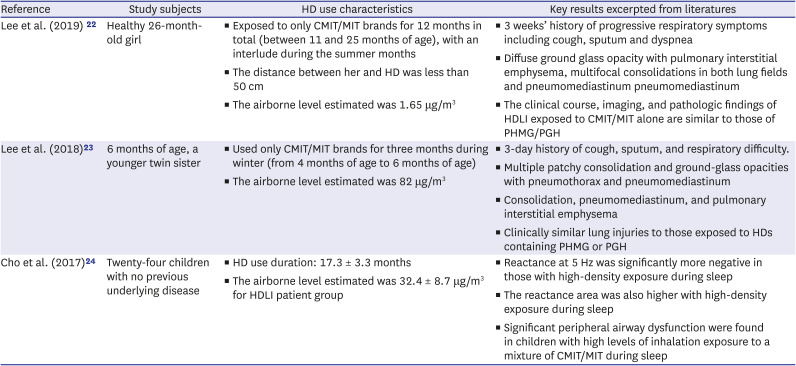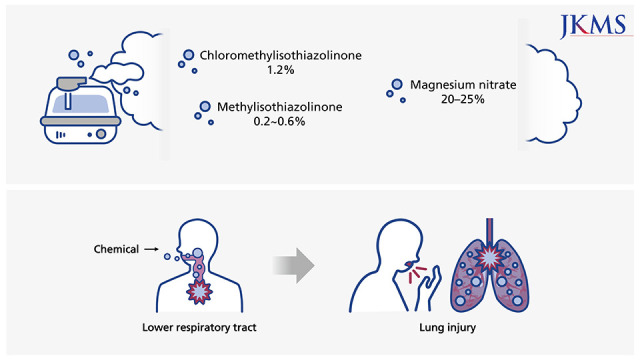1. de Groot AC, Weyland JW. Kathon CG: a review. J Am Acad Dermatol. 1988; 18(2 Pt 1):350–358. PMID:
3279090.

3. He K, Huang J, Lagenaur CF, Aizenman E. Methylisothiazolinone, a neurotoxic biocide, disrupts the association of SRC family tyrosine kinases with focal adhesion kinase in developing cortical neurons. J Pharmacol Exp Ther. 2006; 317(3):1320–1329. PMID:
16547166.

4. Park DU, Lee S, Lim HK, Kim SY, Kim J, Park J, et al. Comprehensive review on humidifier disinfectant (HD) products, focusing on the number of products and their disinfectant type. J Environ Health Sci. 2020; 46(5):481–494.
5. Kim HJ, Lee MS, Hong SB, Huh JW, Do KH, Jang SJ, et al. A cluster of lung injury cases associated with home humidifier use: an epidemiological investigation. Thorax. 2014; 69(8):703–708. PMID:
24488371.

6. Kim WY, Hong SB. Humidifier disinfectant-associated lung injury: six years after the tragic event. Tuberc Respir Dis (Seoul). 2017; 80(4):351–357. PMID:
28905528.

7. Park DU, Park SK, Kim J, Park J, Ryu SH, Park JH, et al. Characteristics of exposure to chloromethylisothiazolinone (CMIT) and methylisothiazolinone (MIT) among humidifier disinfectant-associated lung injury (HDLI) patients in South Korea. Molecules. 2020; 25(22):5284.

8. United States Food & Drug Administration (USFDA). Fortification recovery. Elemental analysis manual for food and related products–3.4 Special calculations. Accessed February 8, 2022.
https://www.fda.gov/media/89649/download
.
12. Ryu SH, Park DU, Lee E, Park S, Lee SY, Jung S, et al. Humidifier disinfectant and use characteristics associated with lung injury in Korea. Indoor Air. 2019; 29(5):735–747. PMID:
31278778.

14. Friis UF, Menné T, Thyssen JP, Johansen JD. A patient’s drawing helped the physician to make the correct diagnosis: occupational contact allergy to isothiazolinone. Contact Dermat. 2012; 67(3):174–176.

15. Kaae J, Menné T, Thyssen JP. Presumed primary contact sensitization to methylisothiazolinone from paint: a chemical that became airborne. Contact Dermat. 2012; 66(6):341–342.

16. Kaur-Knudsen D, Menné T, Christina Carlsen B. Systemic allergic dermatitis following airborne exposure to 1,2-benzisothiazolin-3-one. Contact Dermat. 2012; 67(5):310–312.

17. Lundov MD, Mosbech H, Thyssen JP, Menné T, Zachariae C. Two cases of airborne allergic contact dermatitis caused by methylisothiazolinone in paint. Contact Dermat. 2011; 65(3):176–179.

18. National Institute of Environmental Research (NIER). Review on the Association between the Use of Humidifier Disinfectant and Health Effect Focusing on Asthma, Interstitial Lung Disease and Pneumonia. Research Report No. NIER-GP2021-051. Incheon, Korea: NIER;2021.
19. Daftary AS, Deterding RR. Inhalational lung injury associated with humidifier “white dust”. Pediatrics. 2011; 127(2):e509–e512. PMID:
21199854.

20. Park SK, Seol HS, Park HJ, Kim YS, Ryu SH, Kim J, et al. Experimental determination of indoor air concentration of 5-chloro-2-methylisothiazol-3(2H)-one/ 2-methylisothiazol-3(2H)-one (CMIT/MIT) emitted by the use of humidifier disinfectant. Environ Anal Health Toxicol. 2020; 35(2):e2020008. PMID:
32600006.

21. Park DU, Zoh KE, Kim J, Choi S, Kwon JH, Jun H, et al. A scientific critique of a Korean Court’s acquittal for involuntary manslaughter related to 5-chloro-2-methylisothiazol-3 (2H)-one/2-methylisothiazol-3 (2H)-one (CMIT/MIT), a humidifier disinfectant (HD) Part I: Material safety, exposure and delivery to target organ from an HD perspective. J Environ Health Sci. 2021; 47(2):111–122.
22. Lee SY, Park DU, Do KH, Jang SJ, Hong SJ. The pathological findings of chloromethylisothiazolinone and methylisothiazolinone-associated lung injury. J Korean Med Sci. 2019; 34(14):e102. PMID:
30977311.

23. Lee E, Son SK, Yoon J, Cho HJ, Yang SI, Jung S, et al. Two cases of chloromethylisothiazolinone and methylisothiazolinone-associated toxic lung injury. J Korean Med Sci. 2018; 33(16):e119. PMID:
29651817.

24. Cho HJ, Park DU, Yoon J, Lee E, Yang SI, Kim YH, et al. Effects of a mixture of chloromethylisothiazolinone and methylisothiazolinone on peripheral airway dysfunction in children. PLoS One. 2017; 12(4):e0176083. PMID:
28453578.

25. Nemery B, Hoet PH. Humidifier disinfectant-associated interstitial lung disease and the Ardystil syndrome. Am J Respir Crit Care Med. 2015; 191(1):116–117. PMID:
25551352.

26. Filipczak PT, Senft AP, Seagrave J, Weber W, Kuehl PJ, Fredenburgh LE, et al. NOS-2 inhibition in phosgene-induced acute lung injury. Toxicol Sci. 2015; 146(1):89–100. PMID:
25870319.

27. Kerger BD, Fedoruk MJ. Pathology, toxicology, and latency of irritant gases known to cause bronchiolitis obliterans disease: does diacetyl fit the pattern? Toxicol Rep. 2015; 2:1463–1472. PMID:
28962489.

28. Kumar H, Singh VB, Meena BL, Gaur S, Singla R. Paraquat poisoning: a case report. J Clin Diagn Res. 2016; 10(2):OD10–OD11.

29. Bourke SJ, Convery RP, Stenton SC, Malcolm RM, Hendrick DJ. Occupational asthma in an isothiazolinone manufacturing plant. Thorax. 1997; 52(8):746–748. PMID:
9337839.

30. Heyder J. Deposition of inhaled particles in the human respiratory tract and consequences for regional targeting in respiratory drug delivery. Proc Am Thorac Soc. 2004; 1(4):315–320. PMID:
16113452.

31. Kang BH, Kim MS, Park YC. Intra-tracheal administration of the disinfectant chloromethylisothiazolinone/methylisothiazolinone (CMIT/MIT) in a pregnant mouse model for evaluating causal association with stillbirth. J Environ Health Sci. 2018; 44(5):468–479.
32. Korea Centers for Disease Control and Prevention. Development of Toxicological Index Identifying Causality between Humidifier Disinfectants and Its’ Diseases. Cheongju, Korea: Korea Centers for Disease Control and Prevention;2019.
35. Song MK, Kim DI, Lee K. Kathon induces fibrotic inflammation in lungs: the first animal study revealing a causal relationship between humidifier disinfectant exposure and eosinophil and Th2-mediated fibrosis induction. Molecules. 2020; 25(20):4684.

36. Kim J, Ju YS, Lee JH, Park DU, Park J, Byun K, et al. A Study on Health Damage of Humidifier Disinfectants Using National Health Insurance Big Data (II) National Institute of Environmental Research, 2019. NIER Research Report No. NIER-SP2020-052. Incheon, Korea: NIER;2020.
37. Dinwiddie R, Sharief N, Crawford O. Idiopathic interstitial pneumonitis in children: a national survey in the United Kingdom and Ireland. Pediatr Pulmonol. 2002; 34(1):23–29. PMID:
12112793.

38. Griese M, Haug M, Brasch F, Freihorst A, Lohse P, von Kries R, et al. Incidence and classification of pediatric diffuse parenchymal lung diseases in Germany. Orphanet J Rare Dis. 2009; 4(1):26. PMID:
20003372.

39. Park DU, Zoh KE, Kim J, Choi S, Lee Sy, Jun H. A scientific critique of a Korean Court’s acquittal for involuntary manslaughter related to 5-chloro-2-methylisothiazol-3(2H)-one/2-methylisothiazol-3(2H)-one (CMIT/MIT), a humidifier disinfectant (HD) Part II: Animal experiments, criteria for HD lung injury, and causality on individual levels. J Environ Health Sci. 2021; 47(3):193–204.








 PDF
PDF Citation
Citation Print
Print




 XML Download
XML Download